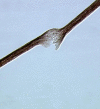Syndromic (phenotypic) diarrhea in early infancy
- PMID: 18304370
- PMCID: PMC2279108
- DOI: 10.1186/1750-1172-3-6
Syndromic (phenotypic) diarrhea in early infancy
Abstract
Syndromic diarrhea (SD), also known as phenotypic diarrhea (PD) or tricho-hepato-enteric syndrome (THE), is a congenital enteropathy presenting with early-onset of severe diarrhea requiring parenteral nutrition (PN). To date, no epidemiological data are available. The estimated prevalence is approximately 1/300,000-400,000 live births in Western Europe. Ethnic origin does not appear to be associated with SD. Infants are born small for gestational age and present with facial dysmorphism including prominent forehead and cheeks, broad nasal root and hypertelorism. Hairs are woolly, easily removed and poorly pigmented. Severe and persistent diarrhea starts within the first 6 months of life (</= 1 month in most cases) and is accompanied by severe malabsorption leading to early and relentless protein energy malnutrition with failure to thrive. Liver disease affects about half of patients with extensive fibrosis or cirrhosis. There is currently no specific biochemical profile, though a functional T-cell immune deficiency with defective antibody production was reported. Microscopic analysis of the hair show twisted hair (pili torti), aniso- and poilkilotrichosis, and trichorrhexis nodosa. Histopathological analysis of small intestine biopsy shows non-specific villous atrophy with low or no mononuclear cell infiltration of the lamina propria, and no specific histological abnormalities involving the epithelium. The etiology remains unknown. The frequent association of the disorder with parental consanguinity and/or affected siblings suggests a genetic origin with an autosomal recessive mode of transmission. Early management consists of total PN. Some infants have a rather milder phenotype with partial PN dependency or require only enteral feeding. Prognosis of this syndrome is poor, but most patients now survive, and about half of the patients may be weaned from PN at adolescence, but experience failure to thrive and final short stature. DISEASE NAME AND SYNONYMS: Syndromic diarrhea - Phenotypic diarrhea - Tricho-hepato-enteric syndrome - Intractable diarrhea of infancy with facial dysmorphism - Trichorrhexis nodosa and cirrhosis - Neonatal hemochromatosis phenotype with intractable diarrhea and hair abnormalities - Intractable infant diarrhea associated with phenotypic abnormalities and immune deficiency.
Figures




Similar articles
-
Identifying Mutations of the Tetratricopeptide Repeat Domain 37 (TTC37) Gene in Infants With Intractable Diarrhea and a Comparison of Asian and Non-Asian Phenotype and Genotype: A Global Case-report Study of a Well-Defined Syndrome With Immunodeficiency.Medicine (Baltimore). 2016 Mar;95(9):e2918. doi: 10.1097/MD.0000000000002918. Medicine (Baltimore). 2016. PMID: 26945392 Free PMC article.
-
Syndromic diarrhea/Tricho-hepato-enteric syndrome.Orphanet J Rare Dis. 2013 Jan 9;8:5. doi: 10.1186/1750-1172-8-5. Orphanet J Rare Dis. 2013. PMID: 23302111 Free PMC article. Review.
-
Syndromic (phenotypic) diarrhoea of infancy/tricho-hepato-enteric syndrome.Arch Dis Child. 2014 Jan;99(1):35-8. doi: 10.1136/archdischild-2013-304016. Epub 2013 Oct 9. Arch Dis Child. 2014. PMID: 24108068
-
Intractable diarrhea of infancy with facial dysmorphism, trichorrhexis nodosa, and cirrhosis.Pediatr Dermatol. 2003 Sep-Oct;20(5):432-5. doi: 10.1046/j.1525-1470.2003.20514.x. Pediatr Dermatol. 2003. PMID: 14521564
-
Tricho-hepato-enteric syndrome (THE-S): two cases and review of the literature.Eur J Pediatr. 2015 Oct;174(10):1405-11. doi: 10.1007/s00431-015-2563-z. Epub 2015 May 15. Eur J Pediatr. 2015. PMID: 25976726 Review.
Cited by
-
Mutations in TTC37 cause trichohepatoenteric syndrome (phenotypic diarrhea of infancy).Gastroenterology. 2010 Jun;138(7):2388-98, 2398.e1-2. doi: 10.1053/j.gastro.2010.02.010. Epub 2010 Feb 20. Gastroenterology. 2010. PMID: 20176027 Free PMC article.
-
Trichohepatoenteric syndrome: founder mutation in asian indians.Mol Syndromol. 2012 Aug;3(2):89-93. doi: 10.1159/000339896. Epub 2012 Jul 5. Mol Syndromol. 2012. PMID: 23326254 Free PMC article.
-
Tricho-hepato-enteric syndrome presenting with mild colitis.Eur J Pediatr. 2009 Aug;168(8):933-5. doi: 10.1007/s00431-008-0861-4. Epub 2008 Nov 4. Eur J Pediatr. 2009. PMID: 18982349
-
A Case of Mild Trichohepatoenteric Syndrome With New Variant Mutation in SKIV2L Gene: Case Report.Cureus. 2021 Nov 9;13(11):e19404. doi: 10.7759/cureus.19404. eCollection 2021 Nov. Cureus. 2021. PMID: 34926006 Free PMC article.
-
Identifying Mutations of the Tetratricopeptide Repeat Domain 37 (TTC37) Gene in Infants With Intractable Diarrhea and a Comparison of Asian and Non-Asian Phenotype and Genotype: A Global Case-report Study of a Well-Defined Syndrome With Immunodeficiency.Medicine (Baltimore). 2016 Mar;95(9):e2918. doi: 10.1097/MD.0000000000002918. Medicine (Baltimore). 2016. PMID: 26945392 Free PMC article.
References
-
- Goulet OJ, Brousse N, Canioni D, Walker-Smith JA, Schmitz J, Phillips AD. Syndrome of intractable diarrhoea with persistent villous atrophy in early childhood: A clinicopatological survey of 47 cases. J Pediatr Gastroenterol Nutr. 1998;26:151–161. doi: 10.1097/00005176-199802000-00006. - DOI - PubMed
-
- Guarino A, Spagnuolo MI, Russo S, Albano F, Guandalini S, Capano G, Cucchiara S, Vairano P, Liguori R, Casola A, et al. Etiology and risk factors of severe and protracted diarrhea. J Pediatr Gastroenterol Nutr. 1995;20:173–178. - PubMed
-
- Philips A, Schmitz J. Familial microvillous atrophy: A clinicopathological survey of 23 cases. J Pediatr Gastroenterol Nutr. 1992;14:380–396. - PubMed
Publication types
MeSH terms
LinkOut - more resources
Full Text Sources

